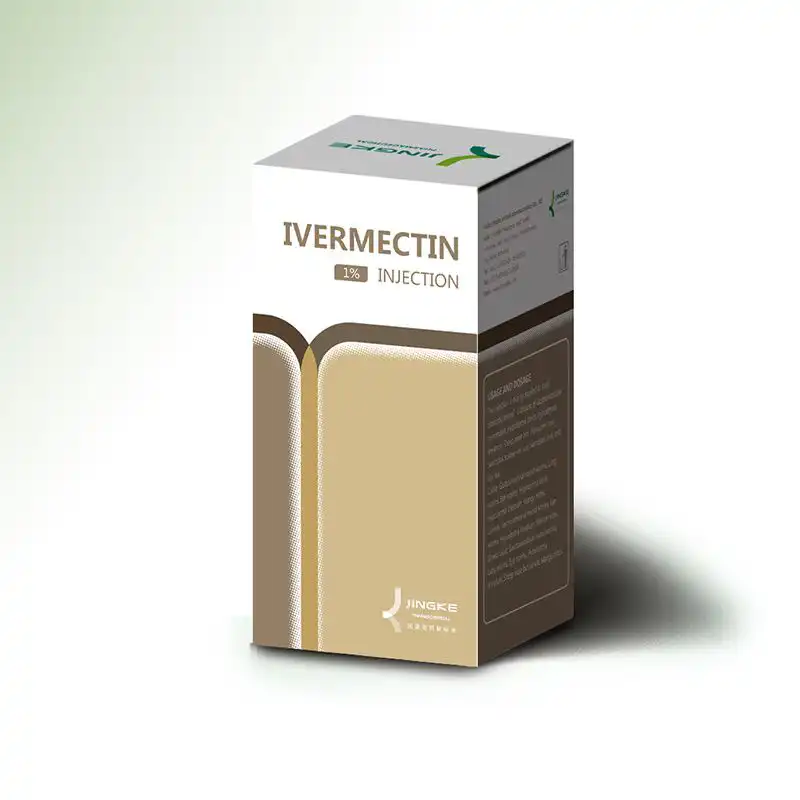Ivermectin is a novel macrolide antiparasitic drug produced by Streptomyces avermitilis. It has a good killing effect on both internal and external parasites, especially nematodes and arthropods, but is ineffective against tapeworms, flukes, and protozoa. Due to its excellent antiparasitic activity and high safety, it has been widely used in veterinary clinics.

In recent years, with social development and improved living standards, more and more people are raising pet dogs. Parasitic infections in companion dogs have increasingly attracted attention. Pet mange is a chronic skin disease caused by mites parasitizing the body surface or epidermis of dogs and cats, characterized by severe itching, pain, and skin inflammation. This disease is difficult to treat, and traditional drug treatments have unsatisfactory effects and are difficult to cure radically. Ivermectin has the advantages of broad spectrum, high efficiency, small dosage, and safety. Clinical practice has shown that it is the preferred drug for preventing and treating this disease in pet clinics and is widely used. This article analyzes 102 cases of canine mite infection treated successively at a pet hospital in Yan’an, Shaanxi, from October 2014 to March 2016. Good therapeutic effects were achieved after using ivermectin preparations. However, irrational use of this product can also cause pet poisoning.
1 Cases and Source of Ivermectin
1.1 Case Sources
From October 2014 to March 2016, a pet hospital in Yan’an received more than 200 cases of skin diseases in dogs and cats. After preliminary examination and microscopic observation of skin scrapings, 102 cases were diagnosed as mite infections, including 13 Golden Retrievers, 12 Samoyeds, 8 Scottish Sheepdogs, 7 Pugs, 11 German Shepherds, 4 Dachshunds, 8 Cocker Spaniels, 5 Chow Chows, 6 Pekingese, 3 Pomeranians, 15 local dogs (mixed breeds), and 10 cats.
1.2 Source of Ivermectin
Commercially available ivermectin injection in Yan’an City.
2 Clinical Application Observation
2.1 Clinical Application
For diagnosed cases of mange in dogs and cats, isolation treatment was implemented. For infections of ear mites, sarcoptic mites, and Pneumonyssoides caninum, subcutaneous injection of ivermectin injection at 0.1-0.2 mg/kg was administered, and a second dose two weeks later was sufficient for treatment. For canine demodicosis, subcutaneous injection at 0.6 mg/kg was required, with an interval of 7 days, for a total of 5 administrations, which could achieve a cure. For cases with secondary infections and mixed fungal infections, antibiotics and antifungal drugs were used in combination, while strengthening nutrition and supplementing multivitamins and minerals.
2.2 Post-Administration Observation and Adverse Reaction Management
According to clinical observation after administration at the recommended dose, mites were generally cured within about a month. Among the 102 cases admitted to our hospital, 81 cases were cured. However, during the medication process, 21 cases developed adverse reactions of varying degrees due to non-compliance with dosage or overdose (self-medication by pet owners). The main symptoms included ataxia, slow breathing, tremors, ptosis, reduced activity, vomiting, and mydriasis. Treatment principles included prompt emesis, gastric lavage, purgation, and simultaneous administration of cardiotonics, liver protectants, antitoxins, diuretics, symptomatic treatment, and fluid therapy, which generally yielded satisfactory results.
2.2.1 Mild Adverse Reactions and Management
Dogs generally showed mild poisoning symptoms after overdose, including moaning, staggering gait, pale conjunctiva, decreased or loss of appetite, followed by involuntary twitching of the muscles at the base of the ears and cheeks. Individual dogs occasionally collapsed suddenly, with head tilted back, neck and limbs痉挛 (spasms), and tongue paralysis protruding from the mouth. Generalized muscle tremors and even convulsions, excessive secretion of viscous fluid from the mouth, and a sluggish response to the surrounding environment were also observed.
For cases in a state of mild poisoning, clinical treatment involved intramuscular injection of cardiotonics, nikethamide, and furosemide; intravenous infusion of glucose sodium chloride, vitamin C, dexamethasone sodium phosphate, inosine, adenosine triphosphate, and coenzyme A; and intramuscular injection of compound vitamin B and a potent detoxification agent. The dosage of drugs could be appropriately increased for severe cases. During clinical administration, the intravenous infusion rate should be slow, generally controlled at around 50 drops/min. The fluid replacement volume on the first and second days could be appropriately increased, combined with diuretics to accelerate the excretion of ivermectin through the urinary tract. Most dogs showed reduced symptoms after 2 days of fluid replacement, and the drug dosage could be appropriately reduced on the third day of treatment. Generally, a cure was achieved within 5-7 days after medication.
2.2.2 Severe Adverse Reactions and Management
Dogs generally showed severe poisoning symptoms after overdose injection of ivermectin, including depression, loss of appetite and thirst, vomiting, frothing at the mouth, intermittent tremors of the whole body muscles, head edema, and conjunctival congestion. Symptoms such as fever up to around 39.8℃, dry nasal planum, dyspnea, severe lethargy, cyanosis of the oral mucosa, unstable gait, drowsiness, and muscle weakness appeared. Severe cases showed weakened or absent reflexes, urinary and fecal incontinence, and a state of deep coma.
For dogs with severe poisoning symptoms, the prognosis is often poor, and medication should be used with caution. Clinical rescue is mainly based on the principles of liver protection and detoxification, cardiac support and fluid replacement, and symptomatic treatment. Intravenous injection of glucose, vitamin C, atropine, and intramuscular injection of potent detoxification agents are selected, and medication is combined according to the characteristics of the symptoms.
3 Efficacy Observation
Ivermectin is the preferred drug for mange in pet clinics. In this study, among the 102 canine cases admitted, except for 5 dogs (3 Scottish Sheepdogs and 2 Chow Chows) that did not survive due to severe poisoning, the remaining 87 dogs and 10 cats were completely cured after using ivermectin injection at the therapeutic dosage, achieving satisfactory results.
4 Conclusion
Ivermectin has achieved good results in the treatment of pet mange. However, based on the analysis of the cured cases, the following conclusions are drawn: First, medication should be strictly prescribed and administered according to the specified therapeutic dose. Second, overdose can cause poisoning, and there is no specific antidote. Third, it has a strong deworming effect on nematodes, ectoparasites, and other arthropods, but its effect on flukes and tapeworms is minimal. It is recommended to combine it with drugs with better anti-fluke and anti-tapeworm effects, such as albendazole, to reduce the inconvenience of multiple administrations. Fourth, the dosage of this product varies among different pet species in clinical practice. Breeds like Scottish Sheepdogs and Collies are highly sensitive to this drug, and caution should be exercised during application, with strict control of the dosage.

